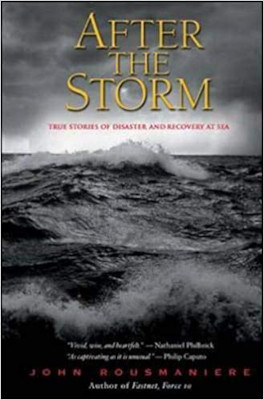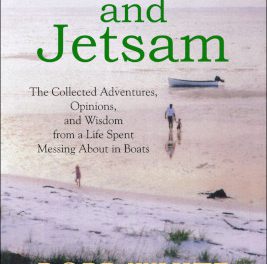
BOYS DIED IN VAIN TRY TO RESCUE DAD
This headline, from the July 2, 1935 Boston Post, chills the heart. It refers to the story of the ketch, Hamrah, and the Ames family, lost at sea during an ocean voyage. John Rousmaniere tells that story and 11 others in After the Storm. If you like sea stories, you’ll love these 12 tales of nautical derring-do. John writes in a spare, evocative style. He provides us with an intimate look at people wrestling with the power of wind and wave. The stories range from the Biblical storms faced by the prophet Jonah and the apostle Paul, to his own discovery of a derelict sailboat in the Atlantic.
John combines meticulous research with his own storm experience to analyze each storm, each wreck, and each death. The case of the Mary Celeste has been debated since Sir Arthur Conan Doyle wrote his wildly fictionalized account of her abandonment. John carefully presents the major theories about the derelict including stories of aliens and the Giant Rat of Sumatra. He then offers the most plausible explanation.
This is not a dry reference book. Every paragraph shows the author’s heart and soul as he discusses our complex relationship with the sea. His storytelling and analysis are superb. After the Storm is ultimately about the meaning of storms and about the emotional and spiritual aftereffects of disaster at sea. If you enjoy reflecting on the big questions of life, you’ll appreciate the philosophical and theological reflection at the book’s heart. John has been out there in good weather and bad. His experience in the 1979 Fastnet drove him to Union Theological Seminary, where he earned a Master of Divinity degree. This book comes from a place deep within himself. He draws parallels between storms on the deep and those other storms of life. He talks about the stages of recovery from tragedy and the disorders that trauma and stress produce.
The book includes a number of heart-stopping photos. Some of the most dramatic were snapped by John himself.
If you love a good sea yarn; if you care about the people who go down to the sea in ships; if you’ve ever pondered over your own storms, nautical or otherwise; you will want to get your hands on a copy of After the Storm. Read it a chapter at a time. Get the feel of the characters who inhabit the story. Vicariously savor their experiences. Let your mind go. Reflect, ponder, enjoy. You’ll be glad you did.
After the Storm, True Stories of Disaster and Recovery at Sea by John Rousmaniere (New York; International Marine/Mcgraw-Hill, 2002; 337 pages)




